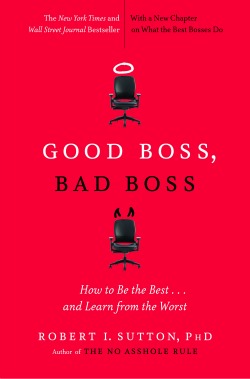Go to article
BY FC Expert Blogger Robert I. Sutton, PhD |
This blog is written by a member of our expert blogging community and expresses that expert's views alone.

This is the third in a series excerpted from a new chapter in the paperback version of Good Boss, Bad Boss, a New York Times bestseller by Robert Sutton. Read the first installment, Are You A Power Poisoned Boss? here, and the second, What Good Bosses Do With Bad Apples, here.
The best bosses strive to simplify things for themselves, their people, and their customers.
In addition to the subtraction mindset already considered, Good Boss, Bad Boss shows the value of checklists, of instilling predictability during scary times, and offers A.G. Lafley’s philosophy that the best managers make things “Sesame Street simple.” These and other examples demonstrate that simplicity, clarity, and repeatable steps can reduce the burdens on people, promote performance, and save money. We human beings especially love simple stories that communicate clear solutions and actions; when Conrad Hilton was on the Johnny Carson show, he pleaded with millions of Americans, “Please remember to put the shower curtain inside the tub.”
Yet there is there is a hazard to this quest: People start believing that every challenge has a clear and simple solution. Stories about past triumphs fuel this predilection. They can make life sound orderly and predictable, even though when the events unfolded, people were probably bewildered and overwhelmed much of the time. As singer Jimmy Buffett put it in his song Migration: “Some things are still a mystery to me/While others are much too clear.”
Bosses have to be prepared to deal with both circumstances. They need to search for clear solutions and simplify things when possible. But it is impossible to be a leader without facing stretches where you and your followers are overwhelmed with the complexity and uncertainty of it all. When this happens, to maintain everyone’s spirits keep them moving forward, and to sustain collective stamina, sometimes it is best to embrace the mess--at least for a while.
I learned this lesson from one of the wisest people I know, David Kelley. I’ve talked about David a lot in the past because I’ve learned so much from him. I first met David at IDEO, the innovation firm that he founded and where he is now chairman, when Andrew Hargadon and I did an 18-month ethnography there in the 1990s. I’ve been an IDEO Fellow for about fifteen years and still have frequent contact with David and others at IDEO. More recently I’ve worked with David at the Hasso Plattner Institute of Design (which everyone calls the d.school), a place at Stanford University, where I teach, and which David (who is also a Stanford professor) founded as well. Our students tackle problems ranging from developing affordable technologies (everything from solar lights to incubators), to generating prototype shows for New York Public Radio station WNYC, to making the all-hands meeting at Timbuk2 more effective.

The challenge of figuring out who ought to do what at the d.school, who makes decisions, how we teach, and a thousand other things has often been bewildering, fueling hurt feelings and open conflict at the worst moments. I remember one particularly ugly meeting where several of us were upset about all this confusion and started engaging in destructive blamestorming. We asked David to clarify things. Instead, he said something like, “I don’t know how to fix it. No one knows how to fix it. Life is messy sometimes. Sometimes the best you can do is to accept that it is a mess, try to love it as much as you can, and move forward.” Ever since then, although I continue to search for clarity (David does, too, as he loves and is adept at fixing problems of all kinds), I remind myself and others there are times when it is wisest to embrace the mess and muddle forward.
Indeed, when I think about the best bosses I’ve studied and talked with over the years, they pass what might be called the Jimmy Buffett test: When it is clear what must be done, they make sure that the right people do the right things as fast as possible. But when it is unclear what to do, they design the work and create a mindset well suited to muddling forward through the mess unti--if they and their followers are good enough and lucky enough--the answers eventually become clear.
No comments:
Post a Comment
Note: Only a member of this blog may post a comment.